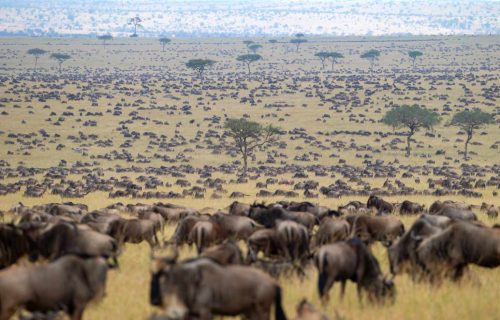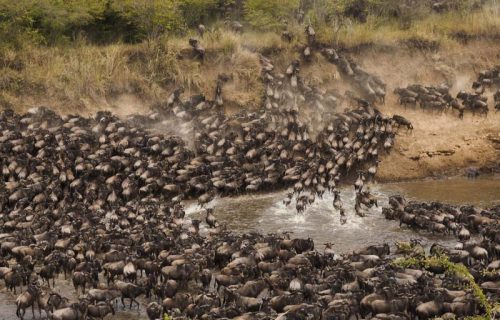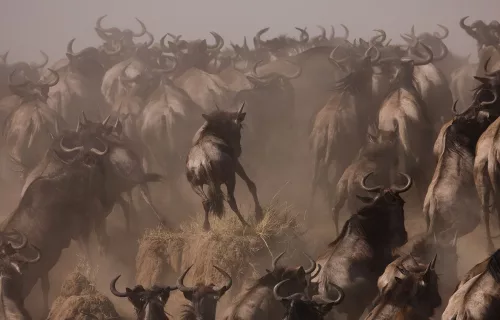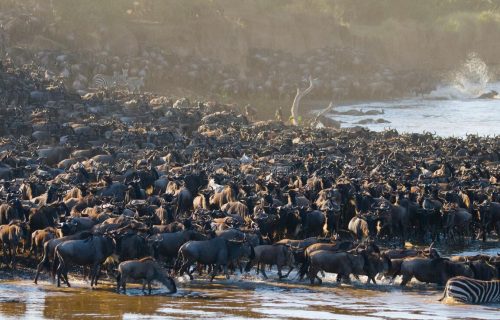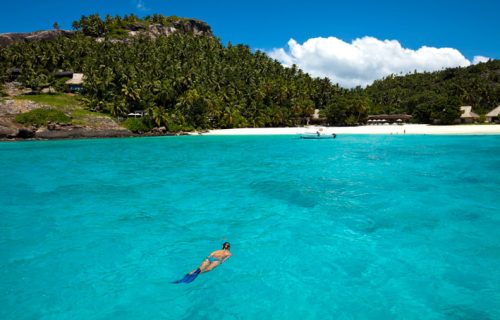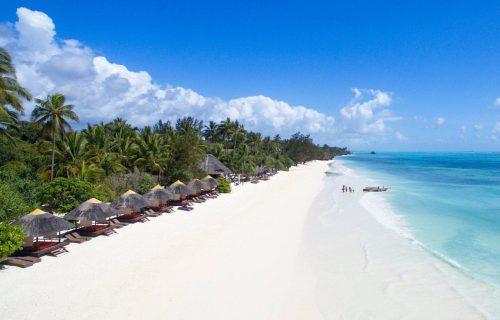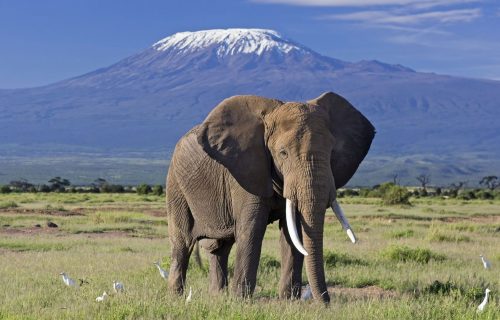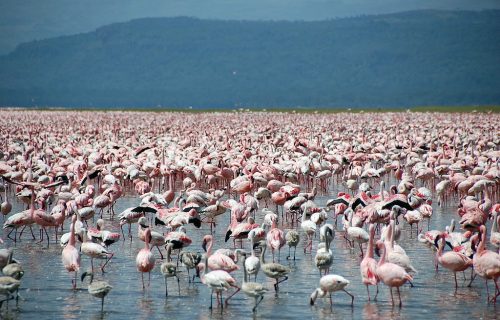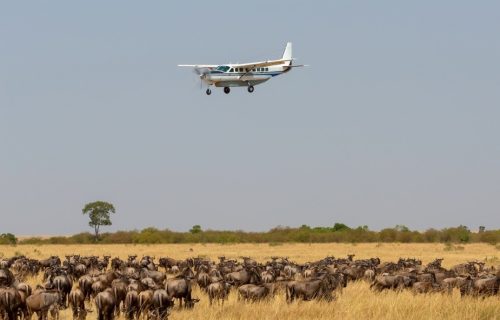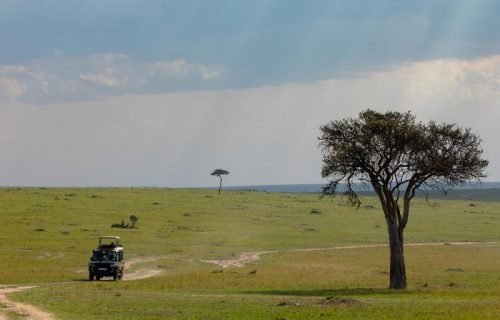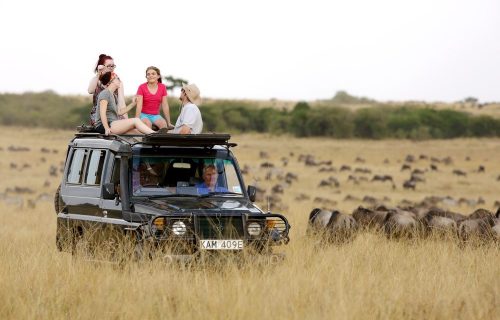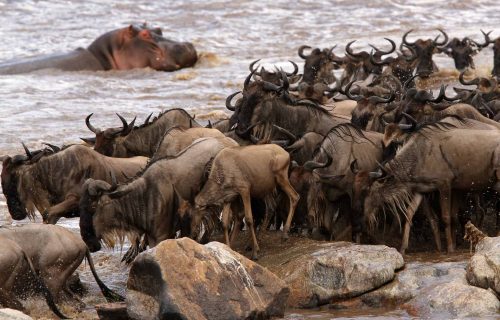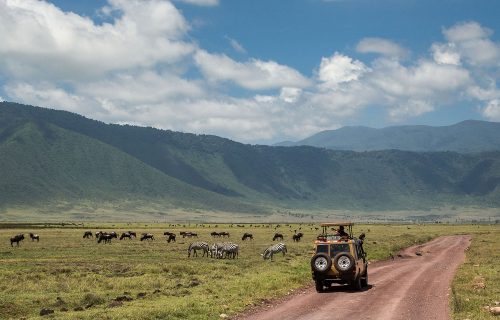The Great Wildebeest Migration in Masai Mara, Kenya
The Great Wildebeest Migration in Masai Mara, Kenya & Best Time. Millions of wildebeest travel from Tanzania’s Serengeti to Kenya’s Masai Mara in what is known as “The Great Migration.” It’s one of the most exhilarating and amazing nature shows ever seen. The animals’ natural inclinations lead them each year to the Serengeti and the Maasai Mara, where they can find better grazing and rainfall. During the seasons, the best time to see the migration is around the middle of July, when the larger herds of wildebeest begin to move into Masai Mara. The migration peaks towards the end of August and begins to taper off by the middle of September.
In the past, up to 1.5 million wildebeest, nearly a million zebra, and a great number of other animals have made the arduous journey, which lasts for many weeks. They must travel over the crocodile-infested Mara and Talek rivers, where many drown trying to avoid the huge nile crocodiles waiting in ambush. For the purpose of brevity, we’ve compiled a list of the most often asked questions (and answers) by travelers about the migration while arranging a safari in Kenya.
The Great Wildebeest Migration in Masai Mara, Kenya
What time of the Year is the Wildebeest Migration?
The migration into the Masai Mara normally commences in July and concludes in late September. However, the precise dates within this timeframe are uncertain until the initial substantial wildebeest herds assemble at the northern boundary of the Serengeti, as they approach the Mara. The earliest herds have been observed to congregate at a particular location for extended periods of time without migrating to the Mara. Consequently, it is challenging to accurately anticipate the commencement of the last phase of their journey.
Wildebeest Migrate From the Serengeti to Kenya’s Masai Mara Preserve
Where do the wildebeest migrate to and from
The migratory patterns of the wildebeest involve a journey from the Serengeti region to the Masai Mara, and are influenced by various factors including climatic conditions, availability of grazing pastures, as well as mating and calving seasons. It is important to note that the wildebeest engage in a migratory pattern throughout the year, predominantly following a clockwise route. This migration spans extensive territories, encompassing the Southern, Central, and Western regions of the Serengeti. Eventually, after a year-long journey, the wildebeest arrive in the Masai Mara region, typically around the months of July and August. The return migration to the Serengeti often occurs in late October, characterized by a gradual dispersal rather than a grand spectacle.
How do you see the Wildebeest Migration
The migration phenomenon can be observed during a safari game drive in the Masai Mara Game Reserve, facilitated by specialist vehicles operated by expert Driver-Guides. Given that there are multiple key locations where the wildebeest traverse the rivers, it can be imperative to gain entry and position oneself at these specific places throughout a full-day excursion within the reserve, as certain lodges and campsites can be situated up to an hour’s drive away from the optimal observation areas. The majority of tourists who specifically visit to witness the migration regard observing the river crossings as a notable aspect of their tour. Consequently, they desire to allocate sufficient time at these crossing points, which, it is worth noting, exhibit slight variations on an annual basis while remaining within a generally similar sub-locality of the reserve.
The Great Wildebeest Migration in Masai Mara, Kenya Safari Packages that might interest you
Not sure where to start? Our best-selling Wildebeest Migration in Masai Mara, Kenya safari packages are here to get you going
Amboseli, Lewa And Masai Mara
Days: 13 | Nights: 12
13 Days Amboseli Lewa and Masai Mara safari. Welcome to Kenya, the country that gave the world wildlife safaris. Kenya is a distinctive location that provides visitors with the ideal fusion of vivid culture, and exhilarating adventure.
Great Wildebeest Migration Safari
Days 9 | Nights: 8
This immersive 9 Days Great Wildebeest Migration Safari in Tanzania will take you to four of its most scenic & biodiverse regions – Arusha, Tarangire National Park, Ngorongoro, & Serengeti National Park.
A Luxury Safari in Kenya
Days: 8 | Nights: 7
This 8 Days Luxury safari in Kenya invites you to see the Masai Mara and Lake Nakuru, two safari hotspots, and see landscapes alive with activity, from massive herds of wildebeest across the Mara to thousands of flamingos.
Kenya And Tanzania Safari
Days: 12 | Nights: 11
12 Days Kenya and Tanzania Safari encompasses the best of Kenya and Tanzania, as well as the most likely route for witnessing the Immense Migration of millions of wildebeest and zebra over East Africa’s great plains.
Kenya Safari And Seychelles
Days: 13 | Nights: 12
Experience the rich wildlife of Kenya on this Kenya Safari and Seychelles Honeymoon and spend carefree days on the beaches of Mahe and Praslin Island in Seychelles. Huge herds of elephants and buffalo, rhinos, lions, leopards.
A Safari in Kenya, Tanzania & Zanzibar
Days: 14 | Nights: 13
14 Days Kenya, Tanzania & Zanzibar Safari tour to game reserves and beaches in Kenya and Tanzania could be just what you’re looking for. Spend a day with giraffes at Nairobi’s lovely Giraffe Manor and try your luck finding.
A Luxury Safari in Kenya
Days: 6 | Nights: 5
“6 Days Safari in Kenya” would undoubtedly be on the bucket list of the daring. The term translates as “going on a voyage” in Swahili, the language of East Africa. This meant traveling upcountry in the period of Hemingway.
A Classic Kenya Honeymoon Safari
Days: 6 | Nights: 5
This 6 Days Kenya Safari will take you on a boat ride in Lake Baringo, as well as a 3-4 hour hike to the south end of Lake Bogoria to see the flamingos and hot springs. We also head to Lake Nakuru National Park.
A Premium Kenya Safari
Days: 9 | Nights: 8
This 9 Days Kenya Safari will take you on a boat ride in Lake Baringo, as well as a 3-4 hour hike to the south end of Lake Bogoria to see the flamingos and hot springs. We also head to Lake Nakuru National Park to observe rhinos.
Explore Masai Mara National Reserve
Days: 4 | Nights: 3
The Maasai Mara National Reserve is Kenya‘s most famous game reserve. 4 Days Masai Mara Lodge Safari From Nairobi provides the opportunity to witness “the big five” as well as numerous other kinds of games.
A Kenya Family Safari
Days: 11 | Nights: 10
The 11 Days Kenya Safari is an Exclusive Family Package. Families may help with elephant conservation while also learning about orphans. Explore the forest on horseback and fly over the skies in an open cockpit aircraft.
Kenya And Madagascar Safari
Days: 13 | Nights: 12
Kenya and Madagascar Safari Start on the grasslands of the Masai Mara before flying across to the island of Madagascar for some lemur tracking through the forests and finally ending on the private reserve and beach of Anjajavy.
Best Time to see Wildebeest Migration in Kenya Month by Month
There is a common misconception among individuals that the Great Migration occurs solely on an annual basis. However, it is important to note that this migration is a continuous phenomena that transpires throughout the whole year. Consequently, this ongoing event presents diverse and captivating wildlife encounters that vary depending on the specific time of year.
The River crossing event is highly sought after throughout the migration and typically aligns with the peak safari season. Consequently, it is commonly assumed that this is the exclusive period when the wildebeest are in motion or observable. The migration crossing typically takes place at Mara River during the late July to August period, extending into parts of September. Similarly, during their return journey south, the crossing is observed from the last two weeks of October through early November.
Therefore, it is advisable to observe and monitor the yearly wildebeest migration in the Masai Mara during specific periods. The following is a broad overview of the approximate locations of the herds throughout the year, taking into consideration the unpredictable nature of their movements, which are influenced by rainfall patterns that can vary in terms of timing and intensity.
The Great Migration – Wildebeest Migration from the Serengeti to the Masai Mara, Crossing Mara River
December To April
The location of the herds, situated between the Ndutu plains and Ngorongoro plains, south of Serengeti National Park, is contingent upon the precipitation patterns. Therefore, the optimal location to reside during this four-month period would be the southernmost region of the Serengeti. During the month of February, it is the period when wildebeests engage in calving activities, presenting a significant opportunity for observing the process of wildebeest birth. The herds exhibit rapid movement as they seek out meadows that offer optimal conditions to sustain their offspring. The likelihood of predator interaction is high, as lions and leopards are migrating to this area to hunt and feed upon the juvenile and susceptible calves. By the conclusion of March or the commencement of April, the herds exhibit a gradual and foreseeable migration pattern as they initiate their movement towards the north. A considerable number of these herds have already departed and are currently situated inside the middle and, in some cases, even the western regions of the Serengeti.
May To June
During this particular season, the migratory herds exhibit a consistent pattern of movement towards the northern regions, driven by their need to access abundant sources of nourishment and water. The phenomenon of migration typically involves the movement of large groups of wildebeest, spanning up to 40 kilometers or 25 miles in length. This spectacle is observable as the wildebeest migrate towards the central and western regions of the Serengeti. These migratory herds, consisting of hundreds of thousands of wildebeest, are often accompanied by zebras, as well as a few Thomson’s and Grant’s gazelles. The conclusion of the rainy season in June typically corresponds with the customary occurrence of the Grumeti River crossing, which is primarily contingent upon the water level of the Grumeti River. It is worth noting that this period presents an opportunity to observe Nile Crocodiles in the vicinity. The current crossing under consideration does not possess the same level of grandeur as the crossings observed at the Mara River.
July To September
The occurrence under discussion pertains to the commencement of a significant event, namely the initiation of a substantial Mara River crossing. The migratory animal populations have successfully arrived at the western Serengeti and Grumeti Reserves, where they are observed engaging in close examination of the rivers they must traverse, characterized by their brown-colored waters.
During the month of August, the group of survivors proceeds in a northward direction, traversing the northern region of the Serengeti and afterwards into Kenya’s Masai Mara National Reserve. The herd undergoes a division into smaller factions, with approximately fifty percent of the animals remaining in the northern region of the Serengeti. The remaining wildebeest proceed to traverse the Mara River, while the majority of the herds relocate to the Greater Masai Mara area, where they consume the abundant resources of lush green grass. Subsequently, they proceed northwards towards the private conservancies of Mara North and Olare Orok.Observing the frenzied assemblage of wildebeests traversing the Mara River often constitutes a highly favored spectacle during the migratory process.
October To November
The wildebeest herds are currently engaged in a migratory pattern characterized by enhanced coordination, as they collectively move in the southern direction. This migration route specifically involves traversing the western Loliondo region and the Lobo area within the Serengeti National Park, with the primary objective of accessing the nourishing green vegetation. The presence of the herds is currently observable in the regions of Kogatende and Lamai, located in the northern part of the Serengeti.
In a typical year, the onset of the short rains typically occurs in November. The herds have currently migrated to the Serengeti region, namely occupying the Lobo, Mbuze Mawe, and Seronera Valley areas, which are characterized by ample water resources. The wildebeest have a concentrated presence in the north-eastern Serengeti, specifically in the vicinity of Lobo, as well as in the southern region of the Serengeti, where fresh grass is available. The process of calving recommences, prompting the predators to reestablish their presence, thereby initiating the recurring cycle of life.
The Great Wildebeest Migration Safari Destinations
A selection of our favorite places for The Great Migration Africa Safari Destinations.
Great Wildebeest Migration Safari Packages
As you can see, organizing a Great Wildebeest Migration in Masai Mara, Kenya is not simple. There are so many things to take into account, and deciding when and where to go can either make you giddy with anticipation or leave you feeling bitterly let down when you miss all the action.
Since the Wildebeest Migration is a once-in-a-lifetime safari adventure, it is crucial to only book with the top safari trip operator. And we can confidently state that this is us because we were named Africa’s Leading Safari Company!
We’ve traveled to East Africa a great deal. The Great Wildebeest Migration in Masai Mara, Kenya has been observed during various seasons of the year. We are able to call the lodge’s owners, managers, and other employees by name. We’ve slept in the beds, taken game drives, and flown in a hot air balloon over the plains. Even better, we were able to observe wildlife without ever leaving the comfort of our beds because we had such a great front-row seat.
Best time to visit Masai Mara to see the Migration
Based on a substantial body of experience spanning many decades, our recommendation would be to visit the Serengeti Masai Mara border during the period from mid July to late August. It is important to note that the migration is a protracted phenomenon that unfolds gradually over several weeks, occurring at various sites along the border. If we were to further refine our analysis to determine the optimal month for observing the migration, August would likely be our preferred choice.
Free tour planning advice
from wildebeest migration experts
To make sure your Great Migration experience is nothing short of extraordinary, we’d be delighted to share our insider knowledge, tips, and recommendations with you. We can also suggest the ideal tour because we are aware of which locations go well together.
What are you still holding out for? Contact our travel specialists right away. They can’t wait to start organizing your ideal Great Wildebeest Migration safari!


